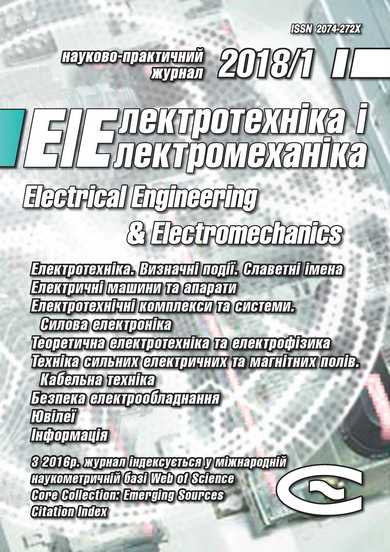DIELECTRIC SPECTROSCOPY OF CASING THERMOSETTING COMPOSITE ELECTRICAL INSULATION SYSTEM OF INDUCTION TRACTION ELECTRIC MACHINES
DOI:
https://doi.org/10.20998/2074-272X.2018.1.02Keywords:
thermosetting composite insulation, induction traction motor, dielectric spectroscopy, replacement circuit, electrical capacitance, dielectric loss tangent, resonance frequencyAbstract
Introduction. Thermosetting composite electric insulation of traction electric motors undergoes significant heating, moisture, overvoltage, vibration. Purpose. The substantiation of the possibility of using dielectric spectroscopy for monitoring the state of the hull thermosetting composite electric insulating system of induction traction motors (ITM) at the technological stage of manufacturing.. Methodology. In the induction traction motors in which the phases of the stator winding are connected to a «star» and do not have a zero point output, in the case of a two-electrode connection of one of the phases and the housing, the combined characteristics of the capacitance and the dielectric loss tangent of the three-phase hull insulation system are measured. Practical value. It is established that at the second resonant frequency near 10 kHz, the tangent of the dielectric loss is the most sensitive to the state of the composite ITM insulation. Dielectric spectroscopy at alternating voltage of the combined dielectric characteristics makes it possible to evaluate the state of the hull thermosetting electrical insulating system at the final stage of manufacturing of induction traction motors.References
1. Yatsko S.I., Karpenko V.V., Vasilenko D.Yu. Investigations of the stability of isolation systems of traction electric machines to the effect of climatic factors. Transactions of Kremenchuk Mykhaylo Ostrogradskiy State University, 2010, iss.4/2010(63), part 1, pp. 134-140. (Rus).
2. IEC 60349-1 Ed. 2.0 b: 2010. Electric traction – Rotating electrical machines for rail and road vehicles – Part 1: Machines other than electronic converter-fed alternating current motors. 2010. 129 p.
3. IEC 60034-18-1:2010. Rotating electrical machines – Part 18-1: Functional evaluation of insulation systems – General guidelines. 2010. 33 p.
4. IEC 60060-1:2010 High-voltage test techniques – Part 1: General definitions and test requirements. 2010. 149 p.
5. Gavrila D.E. Dielectric Spectroscopy, a Modern Method for Microstructural Characterization of Materials. Journal of Materials Science and Engineering, 2014, A4, no.1, pp. 18-26.
6. Koch F. Transforming dielectric response measurements from time to frequency domain. Nordic Insulation Symposium on Materials, Components and Diagnostics (NordIS). Session 4, June 15-17, 2009. Gothenburg, Sweden.
7. Bezprozvannych G.V., Kessaev A.G,Shcherba M.A. Frequency dependence of dielectric loss tangent on the degree of humidification of polyethylene cable insulation. Technical Electrodynamics, 2016, no.3, pp. 18-24. (Rus).
8. Bezprozvannych G.V, Naboka B.G. Influence of parasitic capacitance on the results of measurements of parameters of multicore cables in assessing their technical condition. Electricity, 2011, no.5, pp. 27-36. (Rus).
9. Bezprozvannych G.V., Naboka B.G. Matematicheskie modeli i metody rascheta elektroizoliatsionnykh konstruktsii [Mathematical models and methods of calculation of electrical designs]. Kharkiv, NTU «KhPI» Publ., 2012. 108 p. (Rus).
Downloads
Published
How to Cite
Issue
Section
License
Copyright (c) 2018 G. V. Bezprozvannych, A. V. Roginskiy

This work is licensed under a Creative Commons Attribution-NonCommercial 4.0 International License.
Authors who publish with this journal agree to the following terms:
1. Authors retain copyright and grant the journal right of first publication with the work simultaneously licensed under a Creative Commons Attribution License that allows others to share the work with an acknowledgement of the work's authorship and initial publication in this journal.
2. Authors are able to enter into separate, additional contractual arrangements for the non-exclusive distribution of the journal's published version of the work (e.g., post it to an institutional repository or publish it in a book), with an acknowledgement of its initial publication in this journal.
3. Authors are permitted and encouraged to post their work online (e.g., in institutional repositories or on their website) prior to and during the submission process, as it can lead to productive exchanges, as well as earlier and greater citation of published work.





